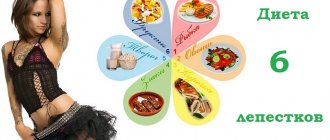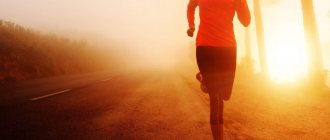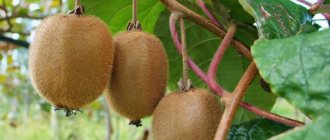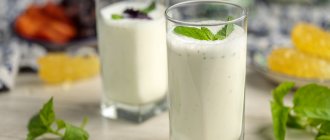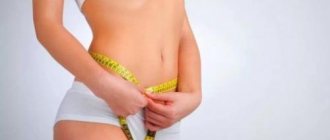Share:
A drinking diet is an effective way to quickly lose extra pounds. This type of nutrition is used not only for weight loss, but also for the purpose of detoxifying (cleansing) the body. Thanks to the consumption of liquid food, the load on the gastrointestinal tract is reduced, and the body starts recovery processes.
Mechanism of action

The benefits of a drinking diet for weight loss appear gradually:
- on the first day, the body rebels against such a nutritional system - you feel tired, bad mood, severe bouts of hunger, but by the third day you will begin to get used to this state of affairs and rebuild - accordingly, the feeling of hunger gradually dulls;
- During the first week, a superficial cleansing of the body occurs;
- on the second - the liver and kidneys are freed from toxins;
- on 3 and 4 - general cleaning at the cellular level.
As a result of these processes occurring in the body, fat reserves are consumed, resulting in weight loss.
Chocolate additive
The chocolate-drinking diet is one of the varieties of the traditional one. It is also hard, but sitting on it is both useful and pleasant. During it, you can eat chocolate, which will correct the mistakes of the traditional system - it will give the body a feeling of joy and taste! For those with a sweet tooth, chocolate diet is a real find! After all, you can lose weight and enjoy it at the same time!
Its duration is no more than 7 days. You can eat no more than 2 chocolate bars (40 g) per day. In addition, you are allowed to wash them down with a cup of coffee without milk or sugar. However, after eating you are not allowed to drink or eat for 3 hours.
The negative side of this diet is its contraindications. It is forbidden to eat this way for those who suffer from liver disease and hypertension.
During the period of the chocolate diet, you can lose up to 6-8 kilograms of excess weight.
The insidiousness of liquid food
A drinking diet for 7 days can work without harm to health - this is the optimal period for losing weight on liquid food. Longer options are fraught with side effects, including:
- coating on the tongue and strong breath (these are typical side effects for the first days of a drinking diet);
- nausea;
- irregular bowel movements;
- diarrhea or constipation;
- dizziness;
- anemia;
- spots in the eyes;
- flatulence;
- gurgling in the stomach;
- disturbances in the functioning of the kidneys (they simply cannot cope with the volume of fluid);
- severe swelling in the morning.
If the menu is drawn up incorrectly or the drinking diet is abandoned too quickly, the consequences can be very unpleasant: the gastrointestinal tract will continue to function incorrectly for a long time, refusing to digest solid food. In some cases, even drug treatment may be required, as gastritis and anorexia may develop.
To minimize the harm of this food system, it is necessary to strictly follow the recommendations of specialists and contraindications to it:
- weakening of the body;
- pregnancy;
- lactation;
- cystitis;
- any problems with the gastrointestinal tract;
- kidney and liver diseases;
- pressure surges;
- cardiovascular failure;
- tendency to swelling;
- varicose veins;
- adolescence and old age;
- mental problems.
Many experts believe that if you have any health problems, this method of losing weight will be dangerous, and therefore it is better to abandon it.
Contraindications
The drinking diet is contraindicated in the following cases:
- Disorders of the cardiovascular system.
- Diseases of the gastrointestinal tract.
- Hypotension and hypertension.
- Kidney failure.
- Period of pregnancy , lactation (breastfeeding).
- Cannot be used by those who are prone to swelling.
If the immune system is weakened and during the postoperative period, the use of any diets is strictly prohibited. To effectively use a limited table, it is necessary to undergo examination to exclude factors that are contraindications in order to avoid negative consequences.
Advantages and disadvantages
Before you go on a drinking diet, find out all its pros and cons, so as not to be disappointed later and not harm your own body.
Advantages
- Efficiency: results if the recommendations are followed correctly can be up to 7 kg per week.
- Thorough cleansing of the body.
- Excess energy that was previously spent on digesting solid food is released, resulting in a feeling of lightness and improved mood.
- The stomach is significantly reduced in volume, and after a drinking diet without discomfort, you will eat less than usual.
- Weight decreases quickly.
Flaws
- Constant feeling of hunger and desire to chew something.
- Instead of the promised surge of vigor, there is often a feeling of constant fatigue and lethargy.
- The stomach quickly gets used to liquid food and then refuses to work with solid food - that’s why the right solution is so important for this diet.
- Many contraindications and side effects.
- An unbalanced diet leads to a deficiency of vitamins and minerals.
- It will be difficult to maintain the results achieved.
- The body experiences serious stress throughout the hunger strike (as does the person losing weight).
The drinking diet has more disadvantages than advantages - this is a reason to think about whether such a weight loss system is suitable for you. To resolve doubts, you should consult a doctor.
Features of compliance
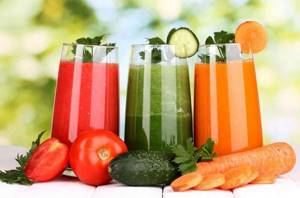
Useful recommendations will make it easier to endure a hunger strike and improve your weight loss results.
Product Lists
What you can drink:
- water;
- vegetable and fruit juices, but not packaged store-bought ones, but only freshly squeezed;
- low-fat broths - meat (chicken, veal or beef), vegetable (beetroot, potato), fish;
- soups of puree and creamy consistency;
- dairy and fermented milk drinks of minimal fat content;
- jelly;
- tea - green, black, herbal;
- compotes;
- cocoa (some nutritionists include it on the list of prohibited foods);
- smoothie.
Prohibited products:
- solid food;
- packaged juices;
- alcohol;
- coffee;
- sugar and sweeteners (do not add them to tea);
- carbonated drinks,
- honey;
- gum;
- dairy and fermented milk drinks with a high fat content;
- pork or lamb broths;
- marinades, brines;
- hot spices;
- any oils - vegetable and animal;
- ice cream.
Rules
The basic rules of the drinking diet are:
- You can't chew anything.
- It is necessary to constantly monitor the regularity of bowel movements: if constipation or diarrhea occurs, the drinking diet is stopped.
- Drink the last drink 2 hours before bedtime, so as not to wake up with swelling the next morning.
- Try to diversify your diet, strictly adhering to the list of what you can drink during the diet.
- Consult your doctors before switching to such a diet.
- The volume of liquid drunk per day should not exceed 5 liters.
- The volume of 1 serving is 200 ml (glass).
- The optimal daily calorie content of food is 1,200 kcal, the upper limit is 1,400.
Entry
If you do not prepare the body for a change in diet, you can disrupt the functioning of the gastrointestinal tract. Usually the first day is the most difficult, since the stomach is seething and asks for solid food, and the feeling of hunger does not allow you to work and makes you suffer from temptations. But if you ensure a smooth entry into the diet, weight loss will take place more calmly and without harm to health.

Such preparation is simply necessary. True, with such a smooth entry, it will last for 2-3 weeks, or even 30 days, but you will be sure that you will not break down and harm your own health.
Exit
You should also be very careful when leaving the drinking diet. If you pamper your stomach with liquid food all week and then suddenly dump solid food on it, it simply will not cope with such a load. The longer the hunger strike, the longer it will take to return the body to a normal nutritional system.
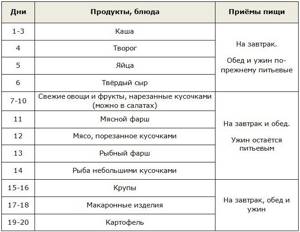
Prohibited Products
As you already understand, any solid foods are prohibited, and the very fact of chewing food is taboo on this diet. But many people think that since the diet is drinking, it means you can drink everything. We will indicate which foods should not be consumed despite the fact that they are liquid:
- carbonated drinks;
- alcohol;
- thick cream soups (which still need to be chewed a little);
- thick smoothies;
- fatty dairy products (milk, kefir, fermented baked milk - everything should have no more than 1% fat content);
- cocoa;
- drinks containing sugar.
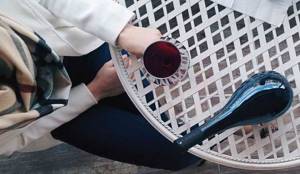
Variety of options
There are different options for a drinking diet depending on the timing of weight loss and the range of drinks in the diet.
- Hard for 3 days
If you want to quickly lose 3-4 kg, a strict diet for 3 days will help, which can only be followed by exclusively healthy people. Thick liquids such as jelly, kefir, fermented baked milk, puree soup, and broths are also prohibited here. Sweet and high-calorie juices are also not welcome.
The scheme is simple: you need to drink 8 glasses of plain water and 3 glasses of green / black tea with milk a day. It is very difficult to tolerate, but allows you to achieve excellent results and cleanse the body well.
- Long lasting for a month
In the absence of side effects and contraindications, you can extend the diet for 30 days. To do this, it is enough to repeat the menu 4 times for the week. To diversify your diet, you can try new recipes. With the advent of blenders, you can make pureed soup for lunch from almost any product. The main thing during such a long marathon is not to lose your temper, because you will always want to chew something. The recovery from such a protracted hunger strike will need to be extended for another month.
- Striped for 1 or 2 weeks
If you cannot tolerate liquid foods alone, you can try this diet option. Make one day a drinking day, the second a vegetable day. This way you will not let your stomach get lazy and at the same time you will be able to take advantage of this nutritional system.
You can use any vegetables except potatoes. Watch the calorie content of your meals. You need to eat often, but little by little. Salt - minimum. Frying as a cooking method is prohibited.
- Choco-drinking
One of the most enjoyable and delicious ways to lose weight among these diets. During the week, your diet should include only 3 drinks: clean water, cocoa and hot chocolate. Losses can be up to 5 kg. But in reality, few people admire the effectiveness of this option.
And, of course, good results in losing weight can be achieved if you arrange fasting days at least once a month.
Allowed drinks
The drinking diet includes the consumption of the following drinks:
- clean drinking water - at least 1.5-2 liters per day;
- freshly prepared juices - vegetable or fruit, without added sugar, diluted with water;
- tea – preferably green and red tea;
- herbal decoctions - for example, chamomile with the addition of mint.
While following a drinking diet, the following are strictly prohibited: coffee, caffeinated and alcoholic drinks.
Let's focus separately on freshly squeezed juices. Fruits contain useful vitamins and microelements. This is an indisputable fact. But drinking large quantities of freshly squeezed concentrated juices (undiluted with water) is not always healthy.
A high concentration of active substances provokes gastritis and gastric ulcers. In people prone to allergic reactions, concentrated juices can cause severe allergies.
Acid, found in large quantities in some fruits (especially citrus fruits), destroys tooth enamel and causes excessive sensitivity. Carrot juice in large quantities, due to the carotene it contains, can turn the skin orange.
The above does not mean that you should give up freshly squeezed homemade juices in favor of packaged ones from the supermarket. On the contrary, natural fruit juices are beneficial if you dilute them with water and drink no more than 1-2 glasses a day.
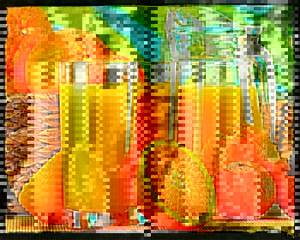
Menu for different periods
To correctly create a menu for the chosen drinking diet option, you need to decide on the timing and focus on the following tables.
Menu for the week
An approximate menu for 7 days is presented in 2 options: as a mono-diet and mixed.
Option 1. Mono-diets - alternating drinking days depending on the drinks consumed.

Option 2. Mixed.
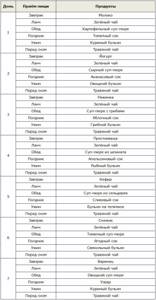
Menu for 14 days
The drinking diet for 14 days differs from the weekly one in that it is aimed at coping with an increased feeling of hunger. Instead of 6 meals there are 7.
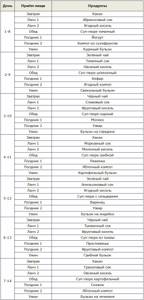
Before bed, another glass of liquid: tea with mint, linden, chamomile, lemon balm or other soothing herbs.
Reviews about the diet
Reviews about the Drinking Day diet confirm its high effectiveness, but problems with digestion and stool are still likely. Therefore, after a diet, it is advisable to sit on oatmeal, and you need to leave the diet gradually. The first drinking day of the diet will be difficult to endure. Weakness may overcome, so you need to spend a lot of time in the air, and replace active physical exercises with static ones.
It is undesirable to increase the duration of the diet, as your health may worsen. The body needs to recover, and to prevent excess weight from returning again, it is necessary to review the diet and eat properly and balanced.
As already mentioned, on the drinking days of the Favorite Diet, you can drink different drinks, but their total calorie content should not exceed 1500 calories.
You should definitely try it to understand how favorably the body will perceive such fasting days.
Recipes
A variety of recipes for drinks and puree soups will help you withstand all the hardships of a drinking diet.
Chicken broth (15 kcal)
Ingredients:
- 3 liters of water (for the first cooking);
- 3 liters of water (directly for broth);
- 500 g chicken breast;
- bulb;
- carrot;
- Bay leaf;
- black pepper (moderate amount);
- salt (minimum).
Preparation:
- Rinse the chicken and remove the skin.
- Let it cook.
- Bring to a boil and rinse the chicken again, change the water, and put it back on the fire.
- Peel the carrots and onions. Without chopping, add to the broth.
- Lightly add salt.
- To ensure clear chicken broth, do not allow it to boil too much and constantly skim off any foam that forms.
- Remove vegetables when they are soft.
- 5 minutes before the end of cooking, add a bay leaf to the broth and sprinkle with pepper.
- Let it brew for half an hour.
- Remove the chicken and bay leaf.
- Strain.
Tomato puree soup (100 kcal)
Ingredients:
- 500 ml chicken broth;
- 150 grams of tomatoes;
- 200 g eggplants;
- carrot;
- 50 grams of shallots;
- 10 ml olive oil;
- sea salt (a little).

Preparation:
- Fry grated carrots and chopped onion in hot oil.
- Peel the eggplants, cut into slices, add to the carrots and onions.
- Peel the tomatoes, remove the stem, and chop coarsely. Add to other vegetables.
- Add some salt.
- Simmer for 15 minutes.
- Pour in chicken broth, bring to a boil, cook for 5 minutes over low heat.
- Transfer the mixture to a blender and blend until pureed.
Uzvar (32 kcal)
Ingredients:
- 100 grams of dried apples;
- 100 grams of dried pears;
- 100 g prunes;
- 50 g raisins;
- 3 liters of water.
Preparation:
- Pour water over the dried fruits and leave for half an hour (or overnight).
- Rinse them thoroughly several times under running water.
- Pour water, boil, keep on fire for 5 minutes.
- Remove from the stove, cover with a lid, leave for 4 hours.
- Strain.
Oatmeal jelly (50 kcal)
Ingredients:
- 300 grams of oatmeal;
- 1 liter of water;
- 50 grams of black bread, already stale;
- salt (minimum).
Preparation:
- Pour water (in different containers) over oatmeal and bread and keep at room temperature for a day to swell. Stir the oatmeal every 4-5 hours.
- Strain, squeeze out both masses, combine together.
- Bring to a boil, add salt.
- Cook over low heat until thickened.
The more often you prepare new drinks for your drinking diet, the more chances you have of not breaking down and passing this test. The only point is to remember to monitor their calorie content, which should not exceed the daily requirement.


